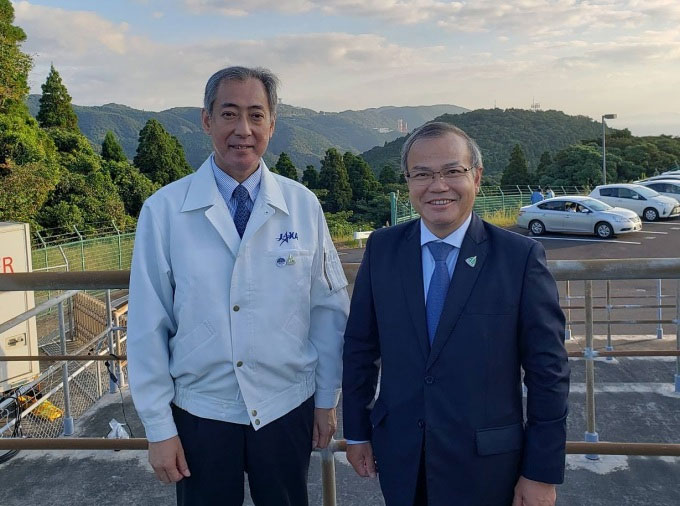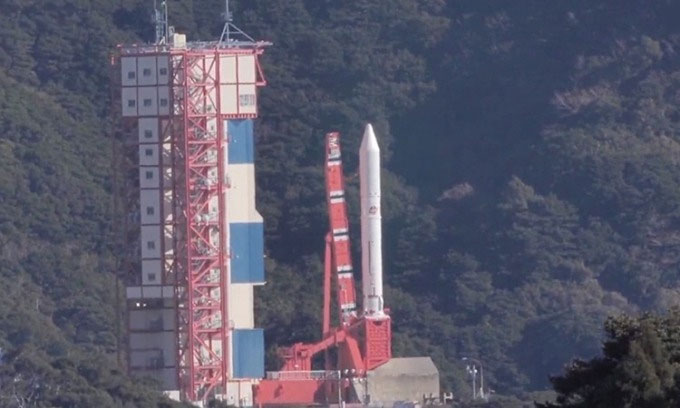On November 9th, at 9:55:16 AM, Vietnam’s NanoDragon satellite was launched into space alongside 8 other satellites from Japan.
The Vietnamese satellite was launched by the Epsilon 5 rocket from the Uchinoura Space Center in Kagoshima Prefecture, Japan. At approximately 9:06:54 AM (Hanoi time), the “Made in Vietnam” NanoDragon satellite successfully detached from the Epsilon 5 rocket, entered orbit, and began its operations in space. It is expected that around 9:30 AM, the NanoDragon satellite will approach the skies over Vietnam. The satellite is designed for monitoring and surveillance of maritime vehicles and is projected to operate in a sun-synchronous orbit at an altitude of approximately 560 km.
Along with the NanoDragon satellite, 8 other satellites from Japan were launched as part of the “Innovative Satellite Technology Demonstration-2” program.
These include:
- One small satellite: RAISE-2 (110 kg) from the Japan Aerospace Exploration Agency; 4 micro-class satellites: HIBARI (55 kg), Z-Sat (46 kg), DRUMS (62 kg), TeikyoSat-4 (52 kg).
- Four cubesat-class satellites: NanoDragon (3.8 kg) from Vietnam, ASTERISC (4 kg) from Chiba Institute of Technology, ARICA (1 kg) from Aoyama Gakuin University, KOSEN-1 (3 kg) from Kochi National College of Technology.
Initially, the launch time was scheduled for 9:48:21 AM (7:48:21 AM Hanoi time), but it was later adjusted to 9:55:16 AM to align with the orbital trajectory of other satellites in the space environment.
At the scheduled time, the Epsilon 5 rocket was ignited, lifted off the launch pad, and successfully deployed 9 satellites into space following the planned trajectory. One minute after the rocket’s successful launch, the first and second stage engines were detached. Three minutes post-launch, the propulsion system was operating normally.
According to the schedule, after approximately 52 minutes, the rocket began releasing the satellites it was carrying into orbit. The first satellite released was RAISE-2. The NanoDragon satellite was the 9th (and final) satellite to be released into space, after departing from the ground for 1 hour, 11 minutes, and 38 seconds.
Ambassador Vu Hong Nam: “Vietnam is inscribing its name on the map of countries conquering space.”
Sharing with reporters from the satellite launch site, Vietnam’s Ambassador to Japan, Vu Hong Nam, expressed his emotions as he witnessed the moment the Epsilon 5 rocket from the Uchinoura launch station began its journey carrying the NanoDragon satellite, developed by scientists and experts from the Vietnam National Space Center (VNSC).
“This sacred moment marks once again the name Vietnam inscribed on the map of nations on the path to conquering space,” he stated. It truly is a feeling of pride mixed with honor to witness the achievements of Vietnam’s space industry. According to the ambassador, this is a commendable initial result from the Vietnam National Space Center, under the Vietnam Academy of Science and Technology, marking an important step forward for Vietnam’s space industry.

Ambassador Vu Hong Nam (right) and Mr. Yamakawa Hiroshi, President of JAXA, at the Uchinoura launch site. (Photo: VT).
He recalled that 10 years ago, when the Vietnam National Space Center was just established, Professor Pham Quang Tuan, the first director of VNSC, showed him only an empty plot of land. Therefore, the current results are a testament to the relentless efforts and contributions of domestic engineers and scientists. “I believe that Vietnam will achieve even greater progress and success on the path of space exploration,” he said, also looking forward to the launch of the LotuSat-1 satellite, expected to take place in 2023. This large satellite integrates many advanced technologies and is anticipated to bring significant value and meaning to Vietnam, not only in economic and scientific development but also in contributing to the nation’s security and defense.
He also hopes that the satellite data collected will be applied to economic development, particularly in marine economy, agriculture, forest management, as well as climate change, and monitoring security and defense activities such as border management and establishing a national basic scientific foundation.
The superior capability of providing specific data information from the satellite system will effectively serve the projects of economic sectors such as urban development planning and industrial park construction. Therefore, Ambassador Vu Hong Nam emphasized the potential role of developing the satellite industry as crucial for both economic growth and security-defense for both public and private sectors.
7:59 AM: Epsilon 5 rocket successfully launches 9 satellites into space.
One minute after the rocket launch was successful, it followed the planned trajectory from the control room.
The first and second stage engines were detached in sequence. Three minutes after launch, the propulsion system was operating normally.
7:48 AM
The Vietnamese satellite will be launched by the Epsilon 5 rocket at the Uchinoura Space Center in Kagoshima Prefecture, Japan, as part of the “Innovative Satellite Technology Demonstration-2” program. The launch time is scheduled between 9:55 and 9:59 AM (7:55 to 7:59 AM Hanoi time).
According to information from the Uchinoura Space Center, today’s weather is sunny with a wind speed of 5 m/s. Factors such as upper-level winds were checked to ensure readiness for a successful launch.

Rocket leaving the launch pad.


















































